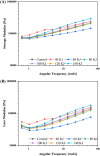Ultrasonication-induced structural and functional modification of starch in wheat flour
- PMID: 40902445
- PMCID: PMC12444191
- DOI: 10.1016/j.ultsonch.2025.107529
Ultrasonication-induced structural and functional modification of starch in wheat flour
Abstract
This study investigated the effects of ultrasonication on the pasting, morphological, thermal, and rheological properties of wheat flour and dough, highlighting its potential as a green and sustainable processing technology. Wheat flour was treated with ultrasonic energy levels ranging from 40 to 140 kJ for 20 min. Rapid visco analysis (RVA) showed that at 40 kJ, peak viscosity increased from 1045.67 mPa·s (control) to 1259.00 mPa·s, and final viscosity rose from 2011.33 mPa·s to 2146.67 mPa·s, indicating enhanced gelatinisation. Differential scanning calorimetry revealed an increase in gelatinisation enthalpy (ΔH) from 8.03 J/g to 9.53 J/g, suggesting enhancement in molecular organisation. Rheological measurements demonstrated that ultrasonicated samples at 40 kJ and 100 kJ exhibited the lowest tan δ, suggesting improved elasticity and structural integrity. FTIR analysis confirmed intensified hydrogen bonding and improved gluten network formation. Low-field NMR and MRI analyses showed that ultrasonication significantly influenced water mobility and distribution within the dough. Moderate energy treatments (40 kJ to 100 kJ) enhanced water retention and network development. Scanning electron microscopy revealed surface roughness and partial granule disruption. These findings confirm that moderate ultrasonication enhances flour functionality by improving hydration, viscoelasticity, and thermal behaviour without the use of chemical additives. Ultrasonication offers an eco-friendly and energy-efficient approach for modifying wheat flour to improve the quality of sustainable flour-based products.
Keywords: Flow behaviour; Starch; Sustainable food processing; Thermal properties; Ultrasonication; Wheat flour.
Copyright © 2025. Published by Elsevier B.V.
Conflict of interest statement
Declaration of competing interest The authors declare that they have no known competing financial interests or personal relationships that could have appeared to influence the work reported in this paper.
Figures











References
-
- Asmeda R., Noorlaila A., Norziah M. Relationships of damaged starch granules and particle size distribution with pasting and thermal profiles of milled MR263 rice flour. Food Chem. 2016;191:45–51. - PubMed
-
- Chi C., Li X., Huang S., Chen L., Zhang Y., Li L., Miao S. Basic principles in starch multi-scale structuration to mitigate digestibility: a review. Trends Food Sci. Technol. 2021;109:154–168.
-
- Ding J., Hou G.G., Dong M., Xiong S., Zhao S., Feng H. Physicochemical properties of germinated dehulled rice flour and energy requirement in germination as affected by ultrasound treatment. Ultrason. Sonochem. 2018;41:484–491. - PubMed
-
- Ezeanaka M.C., Nsor-Atindana J., Zhang M. Online low-field nuclear magnetic resonance (LF-NMR) and magnetic resonance imaging (MRI) for food quality optimization in food processing. Food Bioproc. Tech. 2019;12(9):1435–1451. doi: 10.1007/s11947-019-02296-w. - DOI
MeSH terms
Substances
LinkOut - more resources
Full Text Sources

